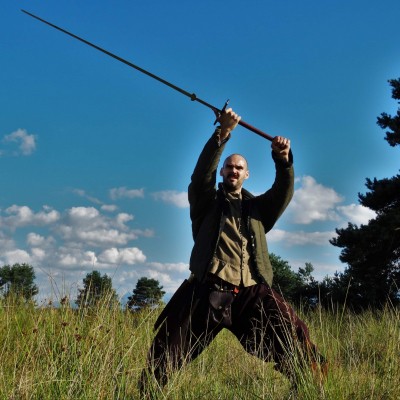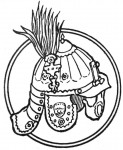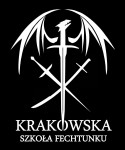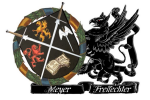Greatsword or a word about an elegant weapon of Spanish masters.
October 12, 2016

A Greatsword can be called any type of two handed sword,which has a high PoB (Point of balance - circa 13 cm or more). It is as well the major difference between them and longswords, which are two handed as well. Also there come differences in sizes, as the latter ones rarely exceed 140 cm, while a greatsword can grow up to 200 cm.
This balance of the sword, causes that with such a sword you cannot swing the same as with the well weighted longsword. A combat with such a weapon is based upon specifc moulinets and hefty cuts utilizeing the effect of this weapons' momentum. Some masters from the period of its use (XVI to XVII century) claim that it could be exercised with the use of a flail.
Gretswords are a great weapon against crowds and for VIP protection. They are a wonderful weapon for support or for small groups, which used appropriately in the battlefield could form something in the shape of modern commando units. Such units were often specialized for shock actions, being able to pierce through the line of pikemen, taking and defending the army standards, a very intersting role among Swedes and Iberians would be boarding actions, used for clearing up the deck before rest of the crew would enter. There were many specially designed techniques used by the Iberians. Montante, a greatsword from Iberian Peninsula, about which we shall write beneath, was sometimes knwon as the Katana Breaker, as it used by some specialists fighting with Japanese Pirates in the Japanese and East Chinese Seas. It was as well known as the Street Thugs were used througout the Europe by many mercenaries for VIP defense. Not mentioning that in Poland for the entire XVIth century a greatsword (of different kind) was a symbol of a knight carried by a man or boy-servant behind the noble.
One may think that a use of this weapon would require vast amount of strength and brutality. Nothing more false! It is one of the most elegant weapon of European arsenal, connecting a great power coming from its weight and balance (they were ranging from 2,2 to 4,5 kilograms) and a wonderful development of its bomechanics, a wonderful fluidity of movement effecting with a great power and speed of attacks. Those always came from the fencers aptitude not his muscle power.
Presented beneath are techniques from the Iberian system of Montante, basing on the master Figuereydo series of cuts and drills called The Rules are a collage of examples of techniques with a Montante greatsword.
Generally there are two types of cuts, Talho and Revez (a cut form the right and from left), yet there are many subtypes of those cuts. Starting from different blade alignments to different sides of the edges one can cut with. For example Revez can be done with a back edge for deflection purpose. The cuts also differe in sizes or method they are delivered, a Talho can be performed as small hit to a restricrted area. It can be a full hew from one side to the other or a continuous circular cut performed in the front. (using the English terminology from the Man yt Wol, it would be Smyte, Hawk and Double Rwnd.) There are as well many types of moulinets like Altibaxo, which is performed by swift change of arms.
It is good to watch how the entire body is working while delivering blows with this magnificent weapon. Old master often suggested and used this weapon as a form of work out and developing the technique. As it can be seen in the video beneath is accompanied by a specific action of the spine and body axis which supports the weapons work, especially once they are performed in slow, what is presesented several time sin the movie below.











